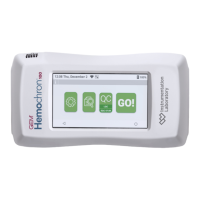1 - Introduction
14 / 112
000HZ6006EN.US • 02 • GEM Hemochron 100 Operator Manual
1.4
Principles of Operation
The GEM Hemochron 100 system measures whole blood activated clotting time using single‑use disposable
test cartridges. Each test cartridge contains all of the reagents necessary for a specied test. The
Operator
inserts a test cartridge into the instrument and then (optional) enters information about the sample either
manually or by scanning the barcode using the barcode scanner. Once the test cartridge is warmed to
37°C ± 1°C (96.8°F–100.4°F), the instrument will prompt the
Operator
to add a blood sample into the sample
well. The
Operator
initiates the test by pressing the (Start Test) icon on the display screen. When the
test begins, the instrument draws blood from the sample well into the test channel of the test cartridge, where
the blood is mixed with the reagent. The remaining blood sample, not needed for testing, is automatically
drawn out of the sample well and into an enclosed waste channel in the test cartridge.
The instrument mixes the sample and reagent by pumping the mixture back and forth at a predetermined rate
within the test channel at a temperature maintained at 37°C ± 1°C (96.8°F–100.4°F). A camera (optical
system) monitors the motion of the sample and reagent in the test channel. As the blood begins to clot, the
ow of the blood sample within the test channel is impeded, reducing its rate of ow.
Flow reduction below a predetermined value signals to the instrument that a brin clot has formed. An internal
timer measures the elapsed time between the start of the test and the clot formation. During the test, the
elapsed time is displayed as Celite equivalent ACT value in seconds, not real-time seconds. Upon completion
of the test, the whole blood clotting time is displayed and recorded by the instrument.

